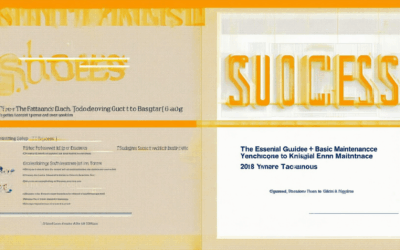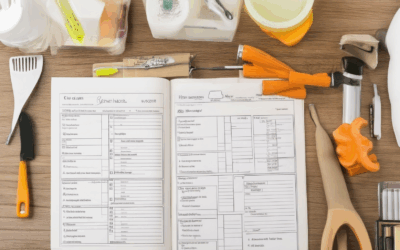Keeping your home in great shape doesn’t have to be overwhelming. With our comprehensive guide to easy house care tips, you can maintain your property with ease and confidence. Whether it’s routine cleaning, landscaping, energy efficiency, or emergency preparedness, we’ve got you covered. Discover how to create a simple yet effective home maintenance schedule that fits your lifestyle. From basic maintenance to advanced tips, this article offers actionable advice to help you manage your home with ease and enjoy the benefits of a well-maintained living space.
Key Takeaways:
- Create a Comprehensive Home Maintenance Checklist: Develop a structured plan covering structural checks, appliance care, and seasonal tasks to ensure thorough home care.
- Schedule Regular Inspections: Regularly inspect systems like HVAC, plumbing, and electrical components to catch issues early and prevent costly repairs.
- Stay Proactive with Monthly and Seasonal Tasks: Adhere to a scheduled routine that includes monthly checklists and seasonal preparations to maintain your home’s health year-round.
- Invest in Energy-Efficient Upgrades: Enhance your home’s efficiency and reduce costs with upgrades that promote sustainability.
- Maintain Landscaping for Prevention: Keep your outdoor spaces tidy to prevent water damage and pest infestations.
- Organize for Efficiency: Implement smart home devices and effective storage solutions to streamline daily routines and enhance productivity.
- Budget for Unexpected Repairs: Set aside funds for unforeseen issues to manage finances wisely and ensure timely resolutions.
- Hire Professionals When Necessary: Seek expert help for challenging tasks to guarantee quality workmanship.
- Keep Records for Future Reference: Maintain detailed logs of maintenance activities and costs for easy access and planning.

How to Properly Take Care of a House
Keeping a house in excellent condition requires a combination of routine maintenance and immediate fixes. Here’s a comprehensive guide to help you manage your home effectively:
- Exterior Maintenance
- Gutter Cleaning: Clean out gutters twice a year to prevent water buildup and damage to your roof and foundation.
- Trim Trees: Regularly trim tree branches near your home to avoid potential damage from falling limbs.
- Roof Inspection: Check for missing shingles, cracks, or damaged areas and repair them promptly to prevent leaks.
- Wall Checks: Look for peeling paint, cracks, or holes and address them to maintain protection and curb appeal.
- Chimney Care: Clean and inspect chimneys annually to remove built-up dust and creosote, reducing fire hazards.
- Indoor Maintenance
- HVAC System: Change air filters monthly and inspect ductwork for leaks or damage to ensure efficient operation.
- Water Heater: Check for leaks and ensure proper functioning to avoid water waste and energy loss.
- Appliance Care: Clean refrigerator door seals and dishwasher filters to maintain efficiency and prevent clogs.
- Flooring: Clean spills immediately and deep clean carpets and hard floors regularly to preserve their condition.
- Yard and Garden
- Prune Plants: Keep shrubs and trees trimmed to maintain their health and prevent encroachment on your property.
- Lawn Care: Properly dispose of grass clippings and leaves to avoid pest infestations and weed growth.
- Landscaping: Trim grass and bushes around your house to maintain proper spacing and prevent moisture issues.
- Foundation and Utilities
- Inspect Foundation: Check for cracks or shifts in the foundation and repair them to prevent structural issues and water intrusion.
- Utility Lines: Regularly check pipes under sinks and in basements for leaks and adjust water pressure as needed.
- Fire Safety
- Smoke Detectors: Test smoke detectors and carbon monoxide detectors monthly to ensure they’re functioning properly.
- Fire Extinguishers: Keep fire extinguishers accessible and functional for emergency situations.
- Security Systems
- Alarm Systems: Test your security alarm and cameras periodically to maintain reliability and peace of mind.
- Attic and Crawl Space
- Inspect Attic: Check for moisture, pests, and structural issues to maintain a healthy living space.
- Crawl Space: Ensure it’s dry and free of pests to prevent damage to your home’s foundation.
By following this checklist, you can ensure your house remains in excellent condition, reducing the need for costly repairs and extending its lifespan. Prioritize tasks based on their urgency and seasonality to stay organized and proactive in your home maintenance efforts.
Basic Maintenance of a House
The basic maintenance of a house involves regular checks and routine tasks to ensure its longevity, safety, and functionality. Here’s a breakdown of essential maintenance activities:
1. Exterior Maintenance
- Gutter Cleaning:** Remove debris and check for leaks or damage.
- Exterior Painting:** Regularly repaint walls and trim to prevent peeling and maintain curb appeal.
- Deck Inspection:** Check for warped boards, loose nails, or structural issues.
- Roof Inspection:** Look for missing shingles, flashing issues, or potential leaks.
2. Interior Maintenance
- Cleaning:** Regularly dust, vacuum, and mop floors and surfaces to prevent dirt buildup.
- Furniture Maintenance:** Move furniture periodically to prevent fading or warping due to sunlight exposure.
- Bathroom Maintenance:** Clean tiles, grout, and fixtures to prevent mold growth and water damage.
- Kitchen Maintenance:** Wipe down countertops, clean appliances, and check for food leaks under cabinets.
3. Systems and Appliances
- HVAC System:** Clean or replace air filters monthly and schedule annual tune-ups.
- Water Heater:** Check for leaks and ensure proper functioning to prevent hot water issues.
- Electrical Systems:** Inspect outlets and switches for tripped breakers or flickering lights.
- Plumbing:** Check for slow drains, leaks, or water damage around pipes.
4. Landscaping and Outdoor Features
- Lawn Care:** Mow, edge, and fertilize grass to maintain healthy growth.
- Garden Maintenance:** Prune trees and shrubs, remove weeds, and check for pests or diseases.
- Patio and Driveway:** Clean and inspect for cracks or uneven surfaces.
- Outdoor Lighting:** Test and replace faulty bulbs or fixtures to ensure safety and functionality.
5. Seasonal Preparation
- Spring Cleaning:** Deep clean the house and prepare for warmer weather.
- Summer Preparation:** Check for termite activity, secure windows against storms, and prepare for heavy usage.
- Winter Preparation:** Clear gutters, drain pipes, and inspect for frost damage.
- Fall Preparation:** Rake leaves, check for falling branches, and prepare for inclement weather.
6. Energy Efficiency
- Insulation Checks:** Ensure attic and wall insulation is adequate to reduce energy loss.
- Appliance Efficiency:** Replace outdated appliances with energy-efficient models to lower utility bills.
- Weather Stripping:** Install or repair weather stripping around doors and windows to save energy.
7. Safety Measures
- Smoke Detectors:** Test and replace batteries regularly to ensure functionality.
- Carbon Monoxide Detectors:** Maintain and test these devices to protect your family.
- Fire Extinguishers:** Keep them accessible and ensure they are in working order.
- Locks and Security:** Regularly change locks and ensure security systems are functioning properly.
By staying proactive with these maintenance tasks, you can extend the life of your home, prevent costly repairs, and ensure a safe and comfortable living environment. For professional assistance or further guidance, visit Sams Maintenance .

What is the 1 rule for home maintenance?
The 1 rule for home maintenance is to allocate 1% of your home’s purchase price annually for repairs and upkeep. This rule has evolved over time to account for modern construction costs and inflation, making it a practical guide for homeowners.
- The 1% Rule: Set aside 1% of your home’s value for maintenance. For a $300,000 home, this means $3,000 annually or approximately $250 per month. This covers unexpected repairs and routine checks.
- Regular Inspections: Schedule annual inspections for major systems like HVAC, plumbing, and electrical components. Early detection of issues can save money and prevent costly repairs.
- Professional Help: Consider hiring professionals for certain tasks, such as gutter cleaning or chimney inspections, to ensure safety and reliability.
- Check for Damage: Regularly inspect for signs of wear, leaks, or damage, especially in high-traffic areas like roofs, windows, and doors.
- Emergency Preparedness: Test smoke detectors and fire alarms annually to ensure they are functioning properly and update outdated units.
For more detailed guidance and professional services, visit Sams Maintenance . Their experts provide comprehensive home maintenance solutions tailored to your needs.

How to Maintain a Home Checklist
A well-maintained home requires consistent care and attention. Here’s a comprehensive guide to creating and sticking to a home maintenance checklist that ensures your living space remains in excellent shape year-round.
Key Components of a Home Maintenance Checklist
- Structural Checks: Inspect walls, floors, and ceilings for signs of damage or wear. Look for cracks, peeling paint, or loose tiles.
- Appliance Care: Schedule regular maintenance for major appliances like refrigerators, dishwashers, and HVAC systems. Replace worn-out parts as needed.
- Systems Inspection: Check plumbing, electrical systems, and HVAC units for proper functioning. Ensure all pipes and wires are in good condition.
- Landscaping: Maintain outdoor spaces by trimming trees, bushes, and lawn areas. Clean gutters and downspouts to prevent water buildup.
- Emergency Preparedness: Keep a kit ready for common emergencies, including tools, first aid supplies, and important documents.
Monthly Home Maintenance Checklist
January
- Check for leaks in pipes and fixtures.
- Clean and service your furnace.
- Inspect chimneys and flues for damage or blockages.
- Test smoke detectors and carbon monoxide alarms.
February
- Service your roof for any necessary repairs or cleaning.
- Check for early signs of termite infestation.
- Prune trees and shrubs to maintain healthy growth.
- Inspect windows and doors for proper sealing.
March
- Pressure wash decks, patios, and driveways.
- Check for spring-related pests like ants and spiders.
- Service your air conditioning unit.
- Clean out gutters and ensure they’re free of debris.
April
- Inspect foundation for cracks or shifts.
- Service your lawn mower and other outdoor equipment.
- Check for early signs of mold or mildew in bathrooms and basements.
- Service your water heater and hot water system.
May
- Trim trees and bushes for better airflow and visibility.
- Check for dead branches and remove them to prevent damage.
- Service your pool and spa equipment.
- Inspect for yard waste and plan for composting or disposal.
June
- Check for storm damage on your property.
- Service your garage door and opener.
- Inspect outdoor lighting for functionality and safety.
- Plan for summer entertaining and prepare outdoor spaces.
July
- Inspect for fire hazards like overloaded circuits.
- Service your RV or boat if you have them.
- Check for pests in your kitchen and pantry areas.
- Prepare for summer vacations and secure your home.
August
- Check for signs of wear on your siding and exterior paint.
- Service your deck and patio furniture.
- Inspect for wasps and other insects.
- Plan for back-to-school organization and storage.
September
- Inspect for damage caused by heavy weather events.
- Service your heating system.
- Check for early signs of fall pests like rodents.
- Prepare for cooler weather and adjust your home’s energy settings.
October
- Check for chimney damage and clean your fireplace.
- Service your outdoor power equipment.
- Inspect for signs of moisture in your basement or crawl space.
- Plan for seasonal storage needs.
November
- Inspect for water damage around windows and doors.
- Service your water softener and filtering systems.
- Check for early signs of frozen pipes.
- Prepare for holiday decorations and lighting.
December
- Check for trip hazards indoors and outdoors.
- Service your carpeting and upholstery.
- Inspect for holiday-related fire risks.
- Prepare for end-of-year maintenance projects.
Seasonal Maintenance Tips
- Winter Preparation: Install storm doors and windows. Service your furnace and ductwork. Clear snow and ice from walkways and roofs.
- Summer Readiness: Prepare for summer heat with ceiling fans and window treatments. Schedule AC tune-ups. Plan for outdoor entertaining.
- Fall Cleanup: Rake leaves and clean gutters. Store outdoor furniture and tools. Prepare for cooler weather with layered clothing and blankets.
- Spring Cleaning: Deep clean carpets, curtains, and bedding. Organize closets and storage areas. Plan spring planting and landscaping.
Additional Tips for Home Maintenance Success
- Stay organized with a digital or paper checklist. Use reminders or calendars for important tasks.
- Consider hiring professionals for difficult tasks like chimney cleaning or HVAC servicing.
- Use smart home devices to monitor systems like thermostats and security cameras.
- Keep a record of maintenance activities and costs for future reference.
By following this comprehensive home maintenance checklist, you can ensure your home stays in great shape year-round. Regular maintenance not only extends the life of your home but also enhances your living experience. Remember to stay proactive and address issues as they arise to prevent minor problems from becoming major ones.
How to Manage a Home Easily
Managing a home effectively requires a combination of organization, routine, and proactive approaches. Here’s a step-by-step guide to making home management simpler and more efficient.
1. Create a Home Organization System
- declutter: Regularly go through your home to remove items that are no longer needed or wanted. This creates space and reduces clutter.
- categorize: Group similar items together, such as books, clothes, kitchen utensils, and seasonal items. Use storage solutions like shelves, bins, and drawers to keep everything accessible.
- maintain a master list: Make a list of all household items, including personal belongings, appliances, and supplies. Update this list periodically to reflect changes in your lifestyle or home layout.
2. Establish a Cleaning Schedule
- weekly chores: Assign specific tasks to each day of the week, such as laundry, vacuuming, and bathroom cleaning. Stick to this schedule to prevent tasks from piling up.
- deep cleaning: Set aside time once a month for tasks like dusting ceiling fans, wiping out cabinets, and sanitizing bathrooms. This helps maintain a fresh environment.
- rotate responsibilities: If you live with others, agree on a fair system for sharing household duties. Rotate tasks to ensure everyone contributes equally.
3. Maintain Regular Maintenance Tasks
- check systems regularly: Inspect plumbing, electrical outlets, and HVAC systems to ensure everything is functioning properly. Address issues early to prevent costly repairs later.
- schedule preventive maintenance: Plan regular services for items like your car, lawn equipment, and appliances. This extends their lifespan and ensures reliable performance.
- organize outdoor spaces: Keep gardens, patios, and outdoor tools tidy. Store seasonal items like bikes, winter gear, and holiday decorations in designated areas to save space.
4. Improve Energy Efficiency
- seal leaks: Check doors, windows, and pipes for leaks. Fix them promptly to reduce energy waste and lower utility bills.
- use programmable thermostats: Adjust temperatures remotely to save energy. Program them to match your daily routines for maximum comfort and efficiency.
- install energy-efficient appliances: Replace old appliances with ENERGY STAR-certified ones to reduce power consumption and lower your carbon footprint.
5. Manage Waste and Recycling
- establish recycling zones: Create separate bins for recyclables, compostables, and trash. This makes it easier to sort items correctly and keeps your space clean.
- schedule garbage collection: Know your local trash pickup days and plan accordingly. Reduce overflows by separating bulk items and hazardous waste.
- compost organic waste: If possible, set up a compost bin to dispose of food scraps and yard waste. This benefits your garden and reduces landfill use.
6. Stay Ahead of Repairs
- monitor for signs of wear: Regularly inspect your home for issues like loose handles, peeling paint, or leaky pipes. Address problems early to prevent further damage.
- keep a repair log: Document any maintenance issues you encounter. This helps track repairs and ensures nothing is overlooked.
- hire professionals when needed: For major repairs or tasks you’re unsure how to handle, consult trusted professionals. This saves time and ensures the job is done correctly.
7. Simplify Daily Routines
- automate tasks: Use smart home devices to automate lighting, temperature, and security systems. This adds convenience and reduces the effort required for daily routines.
- delegate tasks: If possible, delegate household chores to family members or hire help. Sharing the load makes managing the home easier and more sustainable.
- meal prep: Prepare meals in advance to reduce cooking time during the week. Store leftovers for future meals to minimize waste and save time.
8. Regularly Review and Adjust
- reassess your needs: Periodically review your home management system to see what’s working and what isn’t. Make adjustments as needed to better suit your lifestyle.
- stay informed: Keep up with trends in home management and technology. New tools and techniques can make your life easier and more efficient.
- seek support: Don’t hesitate to ask for help when you need it. Whether it’s from friends, family, or professionals, having a support network can make managing your home much smoother.
By implementing these strategies, you’ll be well on your way to managing your home with ease and confidence. Remember, consistency and organization are key to maintaining a comfortable and functional living space.

What is the rule for house maintenance?
The primary rule for house maintenance revolves around preparation, prevention, and consistency. Here’s a breakdown of essential guidelines:
- 1% Rule for Maintenance : Save 1% of your property’s purchase price annually for unexpected repairs and routine upkeep. This ensures financial preparedness without overextending your budget.
- Regular Inspections : Conduct annual checks on critical systems like HVAC, plumbing, and electrical components. Early detection of issues saves money and prevents larger problems.
- Replace Old Systems : Plan to replace major systems every 10-15 years. This includes roofs, HVAC units, and appliances to prevent inefficiencies and safety hazards.
- Clean and Maintain : Regular cleaning and minor fixes can extend the life of your home. Address small issues immediately to avoid costly repairs later.
- Consider Energy Efficiency : Upgrade to energy-efficient appliances and systems to reduce long-term costs and environmental impact.
- Inspect Landscaping : Trim trees, inspect gutters, and maintain landscaping to prevent water damage and pest infestations.
- Budget for Repairs : Set aside funds for unexpected repairs and use professional services when needed to ensure quality workmanship.
By following these guidelines, homeowners can protect their investment and enjoy a well-maintained living space. For further insights, explore resources like HomeServe and ServiceMaster for expert advice and maintenance plans.




0 Comments